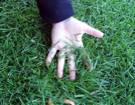I feel like paella tonight

Did you have any idea that you could grow your own saffron?
Saffron is the dried, bright red stigmas of the flower Crocus sativus, which is a relatively easy-to-grow perennial. According to The Farmer's Almanac, it grows well in Zones 6 through 9. It lies dormant all summer, then pushes its purple blossoms up through the mulch just as other plants are succumbing to frost. Cool.
Each blossom offers up to three scarlet stigmas. You plant the bulbs in summer and harvest the stigmas in fall.
A starter supply of about 50 bulbs costs about $30 and will produce about a tablespoon of the spice the first year. However, each year more flowers will grow, and therefore you'll get more of the spice. Ultimately, your investment will pay off. Fresh saffron threads can be used immediately for cooking, or they can be dried and stored.
To dry them, place on paper towels and leave for several days in a warm place. Then transfer them to an airtight container and keep in a cool, dry place.
Saffron is a staple in the diets of Mennonite farmers in places such as Lancaster County, Pennsylvania, where gardeners have been growing it for centuries. Robin, you gotta love that.




























